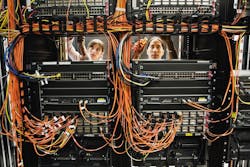The digitization of industry means several things—from less downtime and better machine/device/system analytics to greater remote access for diagnostics, troubleshooting, and repair. And while numerous technologies underlie the move toward industrial digitization, perhaps the most important component are the industrial networks that enable the connectivity and transmission of data needed for industry’s digital transformation.
Amid all the changes taking place in the drive toward greater digitization, three key trends stand out, according to Paul Didier, IoT (Internet of Things) solution architect at Cisco: the shift from proprietary to standard networks (i.e., Ethernet), the use of zero-trust security models, and software-defined networks (SDN).
To reach these goals, Didier said digitization demands a new class of networking. These demands include:
- More bandwidth to accommodate video, automated guided vehicles, thermal imagery and the 3D sensors commonly used in robotics for object detection, collision avoidance, and inspection. In recognition of this need for increased bandwidth, Didier noted that Cisco no longer develops new switches with anything less than gigabit speeds;
- Low-latency, resilient communications to support rich data transfer to industrial applications;
- Greater levels of cybersecurity due to the increased threat surface presented by more connected devices;
- Simplified scale—the ability to deploy and manage more devices across more locations; and
- Edge computing, which provides the ability process large amounts of data closer to the source.
Learn how Single Pair Ethernet and Ethernet-APL are changing the game for industrial Ethernet.
The IT/OT intersection
“All of these [network] demands drive the need for IT/OT collaboration,” Didier said.
In response, Cisco and Rockwell Automation have been working together on the Stratix line of managed switches, particularly the new 5800 series. Part of this collaborative work involves the expansion of Cisco’s IOS (Internetwork Operating System) to IOS-XE. According to Cisco, IOS-XE is designed as single OS (operating system) for enterprise wired and wireless access and WAN to reduce network complexity.
This represents “a fundamental shift of our OS to a software-defined model,” said Didier. “It (IOS-XE) has numerous cybersecurity capabilities built in to provide a playbook for IoT success today and moving forward with 5800 series.”
Features of the Stratix 5800 series switch include:
- All Gb ports for Layer 2 access or Layer 3 distribution switching;
- Expandability from 10 ports to 26;
- Support for precise time synchronization (such as PTP)
- Support for Cisco TrustSec to enable secure network access and Cisco’s Cyber Vision sensor agent; and
- Copper, fiber, and Power over Ethernet ports.
Didier explained that Cisco’s Cyber Vision sensor agent collects data from all ports and analyzes the network traffic to determine what kinds of devices it originates from, who and what devices it’s communicating with, and the type of protocol being used. “It’s a tool that tells you what’s on the network and who is talking to whom,” he said. “It can passively or actively probe a device and helps lock down what’s going on in the network to achieve a zero-trust model and provide information for SIEM (security information and event management).”
Zero trust basically means that devices, users, and applications on the network should be validated and only talk to other systems on the network that they’re supposed to. “It secures all users and application connections and limits the impact from any device that may be affected by malware,” said Didier. Cisco Secure Zero Trust provides visibility as to who and what’s on the network and enables segmentation to shrink zones of trust and grant access based on least privilege and containment.
While an important component of digital transformation, SDN is not as prevalent yet as the use of Ethernet of zero-trust security. Didier said SDN was originally designed to make things easier for IT in terms of automating the process of adding and configuring new devices for the network.
“We have a handful of customers working with this now, but there are still concerns that these tools will operate as expected and not interfere with production operations,” he said.
One reason for this caution around SDN is that operations personnel often don’t have access to IT tools for network management, said Didier. “They typically have poor visibility into the health of the network, which leads to uncertainty about a network outage being caused by network or control system issues.”



